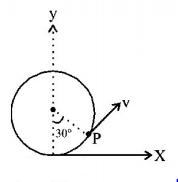Question
A particle of specific charge $$\frac{q}{m} = \pi \,Ck{g^{ - 1}}$$ is projected from the origin towards positive $$x$$-axis with a velocity of $$10\,m{s^{ - 1}}$$ in a uniform magnetic field $$\vec B = - 2\hat k\,T.$$ The velocity $${\vec v}$$ of particle after time $$t = \frac{1}{{12}}s$$ will be (in $$m{s^{ - 1}}$$ )
A.
$$5\left[ {\hat i + \sqrt 3 \hat j} \right]$$
B.
$$5\left[ {\sqrt 3 \hat i + \hat j} \right]$$
C.
$$5\left[ {\sqrt 3 \hat i - \hat j} \right]$$
D.
$$5\left[ {\hat i + \hat j} \right]$$
Answer :
$$5\left[ {\sqrt 3 \hat i + \hat j} \right]$$
Solution :

Time period,
$$T = \frac{{2\pi m}}{{qB}} = \frac{{2\pi }}{{\pi \times 2}} = 1\,s$$
Thus, particle will be at point $$P$$ after $$t = \frac{1}{{12}}s$$
$$\eqalign{ & \vec v = 10\left[ {\cos 30\hat i + \sin 30\hat j} \right] \cr & \vec v = 10\left[ {\frac{{\sqrt 3 }}{2}\hat i + \frac{1}{2}\hat j} \right] = 5\left[ {\sqrt 3 \hat i + \hat j} \right]m{s^{ - 1}} \cr} $$

Time period,
$$T = \frac{{2\pi m}}{{qB}} = \frac{{2\pi }}{{\pi \times 2}} = 1\,s$$
Thus, particle will be at point $$P$$ after $$t = \frac{1}{{12}}s$$
$$\eqalign{ & \vec v = 10\left[ {\cos 30\hat i + \sin 30\hat j} \right] \cr & \vec v = 10\left[ {\frac{{\sqrt 3 }}{2}\hat i + \frac{1}{2}\hat j} \right] = 5\left[ {\sqrt 3 \hat i + \hat j} \right]m{s^{ - 1}} \cr} $$